"RUN! Ebola is coming..."
by
Mol Smith
(August 2014)
A virus, just like a bacterial infection, once it gets a foothold is extremely difficult to stop. The important thing in preventing wide-spread misery and death is to get in early, limit the movement of the carriers, and end contact between the infected and the unaffected. Unfortunately that opportunity was fatally missed!
The longer an infectious agent is loose and the more hosts it can invade, the greater the possibility of that strain going through mutation thus becoming stronger or altering its spreading mechanism. Ebola is not air-borne (yet!), however it can spread via minute droplets of liquid in the air which might be ejected from an unfortunate victim.
If there is one thing you don't want to die from, it's this terrifying infection. Such a death is both agonising and long drawn out. If a nuclear power station was going through a melt-down in North Africa, the world would be centred on that threat and pouring in help and expertise from every direction whilst the populace of the western world would be jumping up and down in the streets screaming for their governments to do something about it. Now here's the bad news, the Ebola outbreak in Africa is a kind of melt-down and far more serious than a nuclear station melt-down. This is not least due to the fact that it looks like it's about to go out of control simply because the world was too slow to act! And before you call me a scare-monger, you should read through the rest of this article and make up your own mind after you understand what you are not being told.
I have been checking the World Health Organisation pages and trawling through their figures and reports over the last few months. It's not good. After months of the infection being present in Africa, teams were sent out to help stop it and to comfort the afflicted. The greatest number of medical personnel attending in the last 6 months are there now and have been since before August. So let's take a look at how effective they have been at stemming the tide. I drew up the following graphic based on information being fed out of the epidemic zone. It represents the growth or decline of the disease during August - the last 4 weeks.
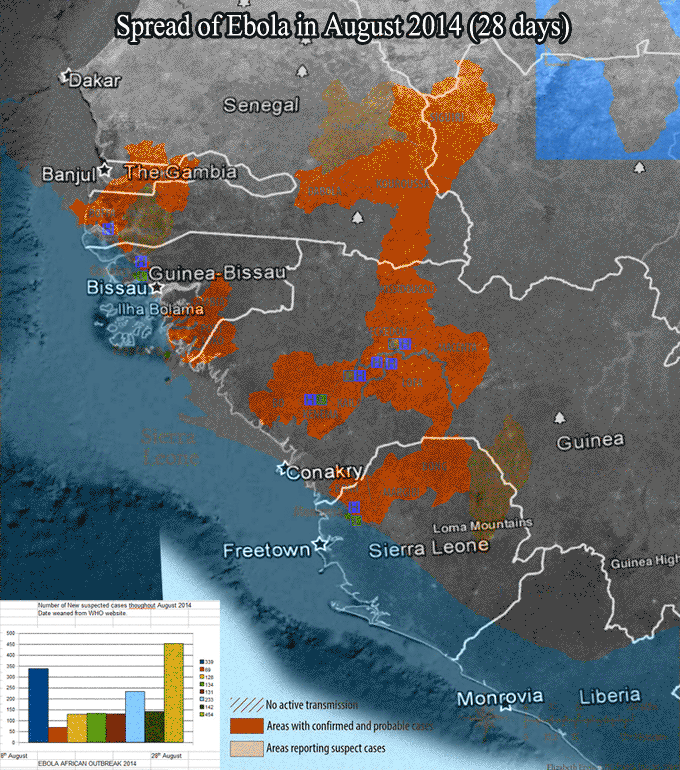
Spread of the Ebola Virus epidemic during the four weeks of August 20214
The tiny graph represents new cases from May to August 2014
and are numbers reported back to the WHO headquarters.
It is fortunate that the immense Sahara desert represents a natural barrier to the spread of the virus north, and the ocean achieving the same to the west. Since the virus needs an animal or human carrier, it can only travel in two directions: east and south. And south is an ocean (great barrier) so it can only go east then. Lo-and-behold it just went east with the first new cases now appearing in Nigeria. Population density is important. The closer the carriers: the faster an infection is spread. Take a look at the table below. These are the countries with Ebola-affected people so far...
| Country Affected | people per Sq.Km | Area in Sq.Metres | Population | Number of Airports |
|
Sierra Leone |
78 |
71,740 |
5,614,743 |
12 airports |
|
Guinea |
32 |
245,857 |
7,775,065 |
14 airports |
|
Liberia |
30 |
111,370 |
3,288,198 |
14 airports |
|
Nigeria |
141 |
923,768 |
129,934,911 |
36 airports |
The loose average of population density throughout the 4 affected countries is 70 people per Sq. Km. That is .25 of the population density of the UK. And our level of density compared to other countries in quite small, 59th in the list of dense countries (population). The population density of the area affected by Ebola compared to a city, say - like London is 0.027 as calculated from below.
| Country | people per Sq.Km | Area in Sq.Metres | Population | |
| United Kingdom |
256 |
243,610 |
62,262,000 |
|
There are more people per Sq.Km in London by a factor of 36 times! Had the Ebola virus started in the centre of London, say, back in May. How many would be affected now? Well, I can give you a fair 'guess-timate' of that. And I will shortly, but first... back to what's happening 'out there'.
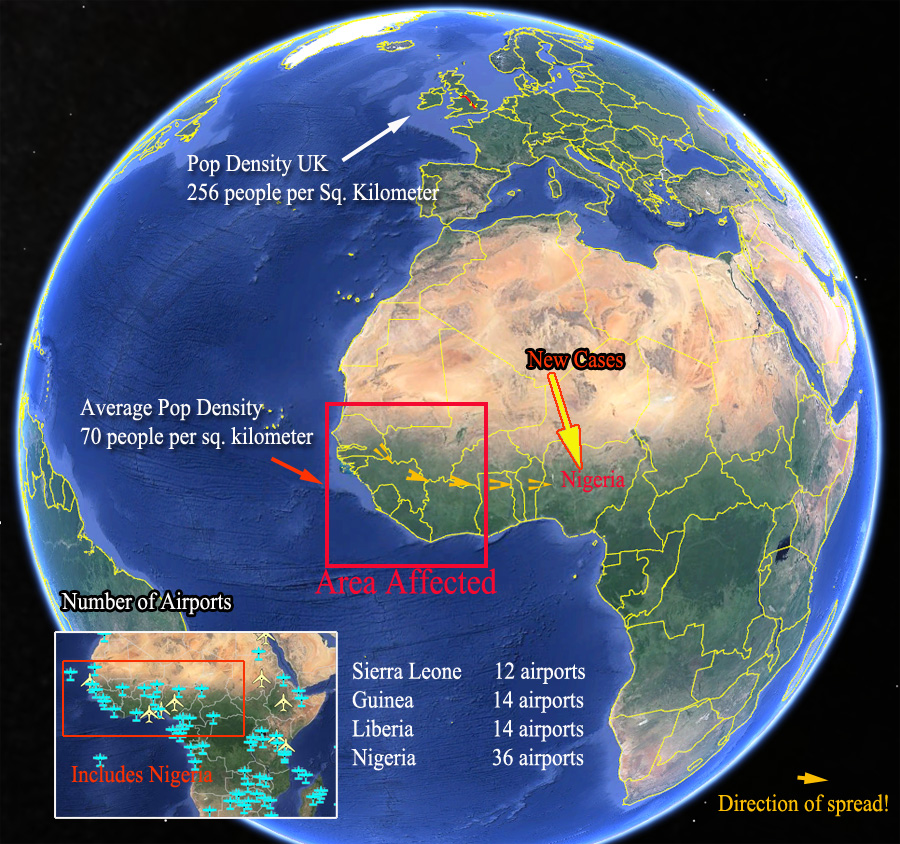
Nigeria has a much denser population. Ebola can now travel both South and East, where-as before it could only really go east. This is dangerous. Not one direction now but two! Now if that isn't telling you something very important, maybe look at the graphs I drew up below by taking the number of cases reported to WHO over the last few months...
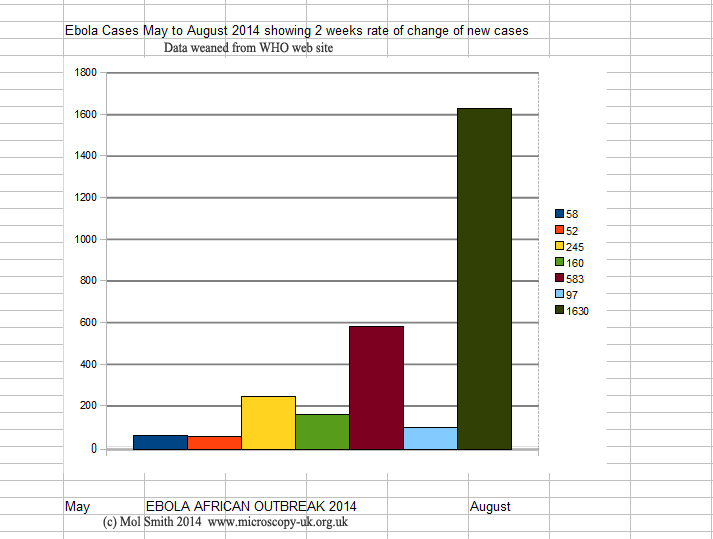
The one above shows the number of new cases (new people affected) between the start of May and the end of August 2014 (now). It appears to be going up exponentially. The graph below shows that despite the heroic act of medical people risking their lives (big-time) to suppress the outbreak, they are failing to achieve that - probably not their fault. People living there are terrified. It hampers the effort. It shows August to have more new cases than at any time before.
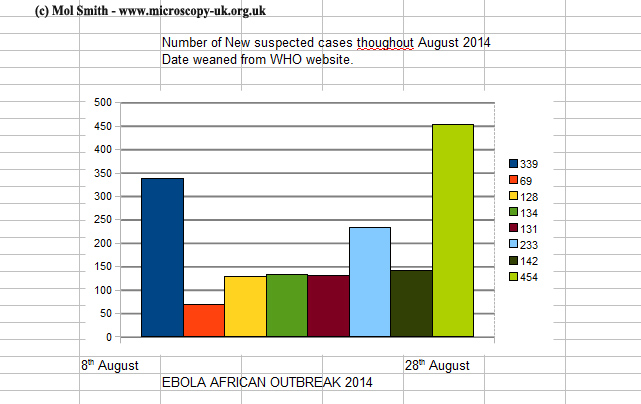
If just one person from that area who is infected - and remember the incubation period can be anything from 2 to 21 days (the time before the person shows any symptoms), turns up in a densely populated city and say, goes shopping in Tesco, his hands holding that trolley will likely pass on the virus to lots of people afterwards. Most infections which are not airborne are spread this way - by legacy contact.
Lets say in the affected area the virus infections double each month. That is approximately what the figures suggest. London is 30x more dense so I suggest the virus will not just infect double the number of citizens each month (as each infected person would likely contact - due to density). It will infect 30x more people. And each of those infected people would again infect 30x double more each month. If you are reading this, live in London, and a single person walks into Tesco in say, Soho...
Well, you will be walking in the city of London on your own (if you survive the outbreak) in less than 12 weeks from now. The entire population will be dead! Oh, of course, there will be some natural survivors, and the rate of survival can vary if good conditions exist, but those conditions would break down so rapidly that the survival rate would quickly return to 10%. London has 10 million people. In just under 12 weeks, only 1 million will be left standing.
Tables used and created by me from figures published on the WHO web site.
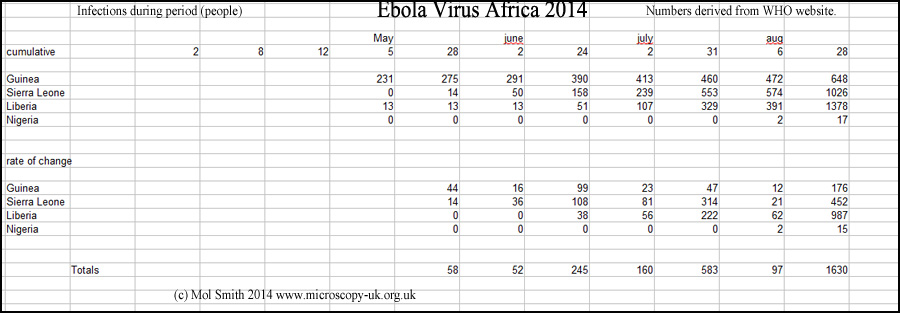
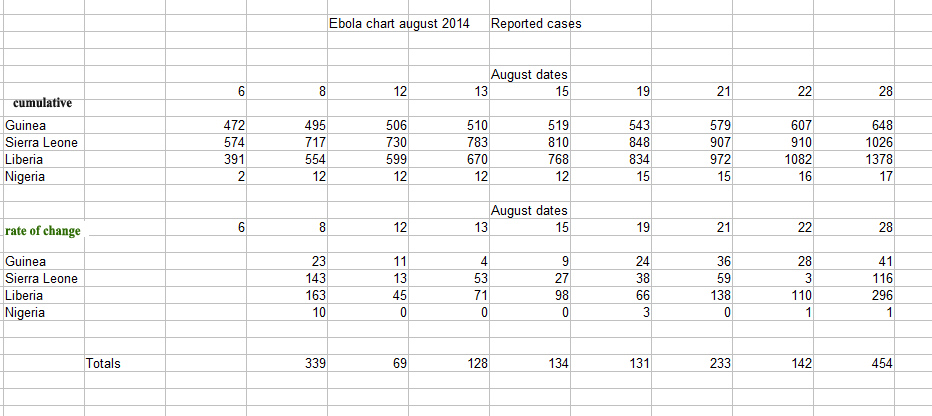
Of course, they will stop it won't they?
If it takes hold in Nigeria... No! They wont. Nigeria has twice the population of the UK and is a perfect place to connect a remotely born virus with a western busy world.
Christmas is coming. I would suggest that when I say run...
run! I don't know where to, but please... not my way.
And in case you still don't realise the threat, this is what Bruce Aylward, WHO's Assistant Director, said: "The number of cases could be much higher than reported. This is not a West African issue or an African issue. This is a global health security issue."
And...
WHO recommends that countries affected by Ebola should conduct exit screening amid concerns that the virus could spread to 10 further countries beyond the four now affected.
"We have never seen an (Ebola) epidemic on this scale," Peter Piot, who co-discovered the virus in 1976 was quoted by the French daily Liberation as saying. "In the last six months, we have been witnessing what can be described as a 'perfect storm' – everything is there for it to snowball.The epidemic "is exploding in countries where health services are not functioning, ravaged by decades of civil war," Piot said.
Piot is former chief of the UN agency UNAIDS and now director of the London School of Hygiene and Tropical Medicine, one of the world's foremost centres of expertise on tropical disease. In the interview, he also castigated "the extraordinary slowness" of international organisations in responding to the outbreak. "The World Health Organization (WHO) only woke up in July," whereas the epidemic began in December last year and health experts sounded the alarm in early March, said Piot.